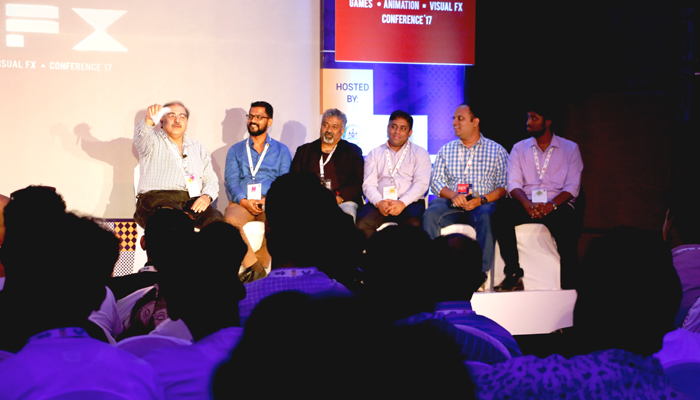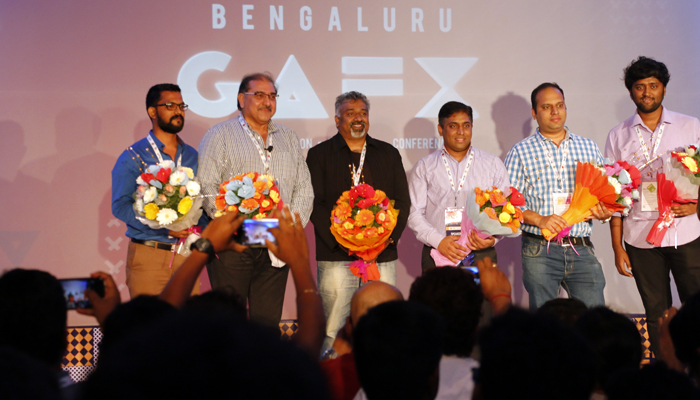This year, we saw panel discussions taking place at GAFX 2017. Among the two panels was ‘Karnataka GAFX success stories’ where successful stories of the animation and VFX studios who are based in Karnataka were highlighted.
The panellists included Thought Cloud Studio (TCS), director – business, Ganesh Pappana; MRT Studios, CEO, Naveen Kumar M; AUM Animation Studios, director, Vivek Bolar; Appu Series, head of marketing, Vishnu Saran; Videogyan, CEO, Vishal T. Moderating this panel was Technicolor, country head and ABAI, president, Biren Ghose.
After a quick introduction of each panellist along with the studios’ showreels, the session was taken ahead.
The Bengaluru based TCS is currently working on its IP Trigo.
Ghose went onto ask TCS’ Ganesh Pappana: Start-up is about learning how to pick yourself, face bumps and much more so what challenges did you have face?
Pappana: Start-up is all about chasing dreams. We had two people who had dreams (V Venugopal and Vijaylakshmi NS). They wanted to create something and we had so many stories to tell the world. We were conscious about the quality of the content which had to be produced. What we needed was the right kind of content with the correct mix and match of people. We had to pick-up right subject and had to think how should we project it.
Since the project required a lot of monetary support, the main challenge was how to get that. Our project ‘Idrajeet’ which is a short animated film of 23 minutes took three years to complete. So, the trust from the investor on the brains behind the project definitely helped us and that’s one thing which needs to be there.

MRT Studios’ has so far worked on 25 movies. They deliver VFX for the Kannada film industry.
Ghose asked MRT Studio’s Naveen Kumar: How do you introduce this new age of technology to filmmakers?
Kumar: That’s one of the biggest hurdles till date – to convince filmmakers that his / her budget is more than enough. Kannada film industry has shoe-string budget and in that visual effects’ isn’t even included. So basically VFX doesn’t even have budget as they often forget that 10 per cent of it needs to be kept aside for VFX. The Kannada film industry want to have effects like Baahubali but at the budget of Rama Rama Re.
Ghose: Do they have problem with just budget or are scared about the technology?
Kumar: As the industry is progressing, they are becoming more open. Now, they let me and my crew do things on field and trust us.
The Mangaluru based Aum animation studio were up next.
Ghose to Aum’s Bolar: Where are you right now and where will you take it from here?
Bolar: We just started the production of an animated series which is going to be a 78×7 minutes series. Fortunately the project is fully funded. We have signed it with Cartoon Network for seven countries and it’s expected to air from first half of 2018.
Currently we have a team of 21 and I wish to expand it no more than 40 as that’s a good number to manage and I feel it is better to have IP with small team.
Ghose: As a small company, how did you manage the costs?
Bolar: Back in 2010, software was a big challenge due to the costs. Hence, we adopted Blender software. Our whole studio runs on the open source pipeline. Initially the software had issues, now it’s really smooth.
The YouTube sensation channel in the kids space, Videogyan has grown leaps and bounds since its launch.
Ghose to Videogyan’s Vishal T: You have taken a different path. Why do kids come to you? Are you happy with the money?
Vishal T: Kids are addicted to YouTube now. We saw the potential of the platform back in 2011 / 12 and so bootstrapped for it. Currently, every week we produce six to eight minutes of content. Analytics helped us understand the user base and get more numbers. We also have a dedicated content analysis team.
We concentrated on not just quality but also business side of it. Being a digital platform, it is important to keep uploading content every week and not after a year. And for that, money was always kept in mind as more content needs to be produced. Currently, we run on then advertising model. However, we are looking at subscription model too and for that we would need to make our own app.
Finally it was time for the one and a half year young IP, Appu Series which is part of Media Fusion.
Ghose to Appu Series’ Vishnu Saran: Your journey has been quite different. Tell us about the marketing part of it.
Saran: We have a lot of content for kids and in that we also generate a lot of educational content. Our marketing strategy has two aspect: Content and aspect. On Facebook we upload small snippets and then give links of the YouTube video below as that’s the monetising platform. These days, Facebook is also coming up with monetising options but that will take some time. Apart from that, Google SEO words also help. We need to see how much the keyword costs. It’s important to keep analysing the data and have strong marketing strategy.
Ghose went on to mention that earlier, we used to observe start-ups in traditional media. Now, there’s a shift as more and more start-ups are growing in audio visual domain.

To make the session more interactive, the floor was open for questions.
Question 1: What is the average time period for production to break-even?
Kumar: Investment should be used wisely by paying artists on-time, followed by the knowledge in which you are investing in. Initially you will break-even. However, it completely depends on the business model on how soon you will monetise.
Ghose further added: Attrition hurts us the most as we take a lot of time to train people as they work on different pipelines and workflows. Our industry is very bespoke. There are 2,742 people at Technicolor whose average age is 25. For them the most important thing is personal growth and learning. Next they see if they are treated well as artists and creative people like working in a place where they are treated well. It is important to give them reviews as they love feedback. The last thing they look at is money.
Question 2: How do you plan to scale up the budgets?
Kumar: I am fine with marginal increase in budget as well.
Ghose: I guarantee that by 2020, 25 per cent of the movie’s budget will be kept aside for VFX.
Question 3: Aren’t you afraid of the IPs being used though modified?
Saran: We don’t use the IPs directly. They are modified so it shouldn’t be a problem.
Ghose: If the IPs are in public domain, things can be used. However, if it has copyright, go for bigger changes not small ones.
It was time to end the session. Ghose went on to share a piece of advice for the aspiring entrepreneurs. He said, “Because of the change in platforms in media world, change is imminent. Even if you are working with an old company, you need to think as start-ups all the time as you need to do many things. There is an opportunity for Bengaluru to have hub for online market for digital marketing globally as we have a dynamic minister now!”

